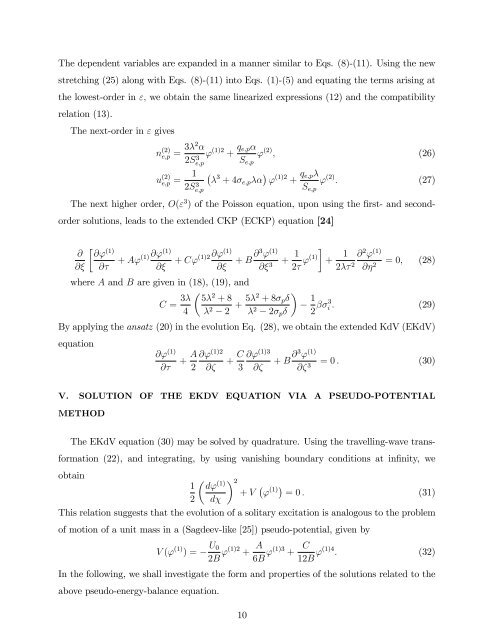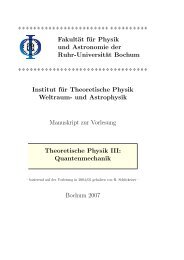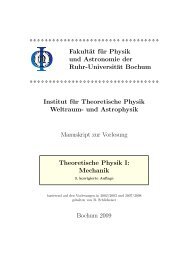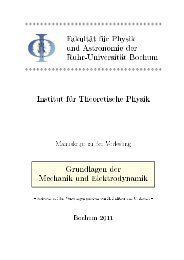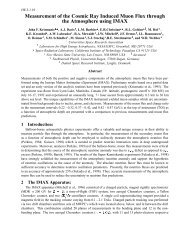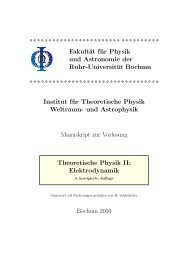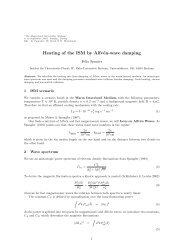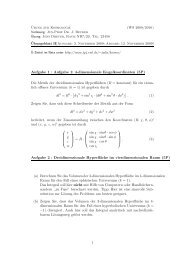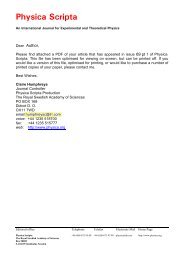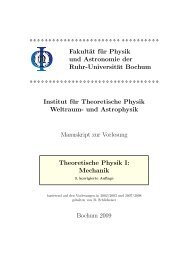pdf here - Theoretische Physik IV - Ruhr-Universität Bochum
pdf here - Theoretische Physik IV - Ruhr-Universität Bochum
pdf here - Theoretische Physik IV - Ruhr-Universität Bochum
Create successful ePaper yourself
Turn your PDF publications into a flip-book with our unique Google optimized e-Paper software.
The dependent variables are expanded in a manner similar to Eqs. (8)-(11). Using the new<br />
stretching (25) along with Eqs. (8)-(11) into Eqs. (1)-(5) and equating the terms arising at<br />
the lowest-order in "; we obtain the same linearized expressions (12) and the compatibility<br />
relation (13).<br />
The next-order in " gives<br />
n (2)<br />
e;p = 32 <br />
2S 3 e;p<br />
u (2)<br />
e;p = 1<br />
2S 3 e;p<br />
' (1)2 + q e;p<br />
S e;p<br />
' (2) ; (26)<br />
3 + 4 e;p ' (1)2 + q e;p<br />
S e;p<br />
' (2) : (27)<br />
The next higher order, O(" 3 ) of the Poisson equation, upon using the …rst- and secondorder<br />
solutions, leads to the extended CKP (ECKP) equation [24]<br />
<br />
@ @'<br />
(1)<br />
(1) @'(1) (1)2 @'(1)<br />
+ A' + C' + B @3 ' (1)<br />
+ 1 <br />
@ @ @<br />
@ @ 3 2 '(1) + 1 @ 2 ' (1)<br />
= 0; (28)<br />
2 2 @ 2<br />
w<strong>here</strong> A and B are given in (18), (19), and<br />
C = 3 5 2 + 8<br />
4 2 2 + 52 + 8 p 1<br />
2 2 p 2 3 i : (29)<br />
By applying the ansatz (20) in the evolution Eq. (28), we obtain the extended KdV (EKdV)<br />
equation<br />
@' (1)<br />
@<br />
+ A 2<br />
@' (1)2<br />
@<br />
+ C 3<br />
@' (1)3<br />
@<br />
+ B @3 ' (1)<br />
@ 3 = 0 : (30)<br />
V. SOLUTION OF THE EKDV EQUATION VIA A PSEUDO-POTENTIAL<br />
METHOD<br />
The EKdV equation (30) may be solved by quadrature. Using the travelling-wave transformation<br />
(22), and integrating, by using vanishing boundary conditions at in…nity, we<br />
obtain<br />
<br />
1 d'<br />
(1) 2<br />
+ V ' (1) = 0 : (31)<br />
2 d<br />
This relation suggests that the evolution of a solitary excitation is analogous to the problem<br />
of motion of a unit mass in a (Sagdeev-like [25]) pseudo-potential, given by<br />
V (' (1) ) = U 0<br />
2B '(1)2 + A<br />
6B '(1)3 +<br />
C<br />
12B '(1)4 : (32)<br />
In the following, we shall investigate the form and properties of the solutions related to the<br />
above pseudo-energy-balance equation.<br />
10


